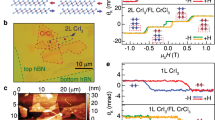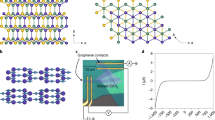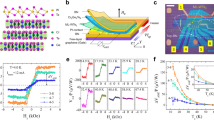Abstract
Magnetic proximity effects are integral to manipulating spintronic1,2, superconducting3,4, excitonic5 and topological phenomena6,7,8 in heterostructures. These effects are highly sensitive to the interfacial electronic properties, such as electron wavefunction overlap and band alignment. The recent emergence of magnetic two-dimensional materials opens new possibilities for exploring proximity effects in van der Waals heterostructures9,10,11,12. In particular, atomically thin CrI3 exhibits layered antiferromagnetism, in which adjacent ferromagnetic monolayers are antiferromagnetically coupled9. Here we report a layer-resolved magnetic proximity effect in heterostructures formed by monolayer WSe2 and bi/trilayer CrI3. By controlling the individual layer magnetization in CrI3 with a magnetic field, we show that the spin-dependent charge transfer between WSe2 and CrI3 is dominated by the interfacial CrI3 layer, while the proximity exchange field is highly sensitive to the layered magnetic structure as a whole. In combination with reflective magnetic circular dichroism measurements, these properties allow the use of monolayer WSe2 as a spatially sensitive magnetic sensor to map out layered antiferromagnetic domain structures at zero magnetic field as well as antiferromagnetic/ferromagnetic domains at finite magnetic fields. Our work reveals a way to control proximity effects and probe interfacial magnetic order via van der Waals engineering13.
This is a preview of subscription content, access via your institution
Access options
Access Nature and 54 other Nature Portfolio journals
Get Nature+, our best-value online-access subscription
$29.99 / 30 days
cancel any time
Subscribe to this journal
Receive 12 print issues and online access
$259.00 per year
only $21.58 per issue
Buy this article
- Purchase on Springer Link
- Instant access to full article PDF
Prices may be subject to local taxes which are calculated during checkout




Similar content being viewed by others
Data availability
The data that support the findings of this study are available from the corresponding author upon reasonable request.
References
Vobornik, I. et al. Magnetic proximity effect as a pathway to spintronic applications of topological insulators. Nano Lett. 11, 4079–4082 (2011).
Korenev, V. L. et al. Dynamic spin polarization by orientation-dependent separation in a ferromagnet–semiconductor hybrid. Nat. Commun. 3, 959 (2012).
Buzdin, A. I. Proximity effects in superconductor-ferromagnet heterostructures. Rev. Mod. Phys. 77, 935 (2005).
Stahn, J. et al. Magnetic proximity effect in perovskite superconductor/ferromagnet multilayers. Phys. Rev. B 71, 140509 (2005).
Scharf, B., Xu, G., Matos-Abiague, A. & Žutić, I. Magnetic proximity effects in transition-metal dichalcogenides: converting excitons. Phys. Rev. Lett. 119, 127403 (2017).
Koren, G. Magnetic proximity effect of a topological insulator and a ferromagnet in thin-film bilayers of Bi0.5Sb1.5Te3 and SrRuO3. Phys. Rev. B 97, 054405 (2018).
Eremeev, S. V., Men’shov, V. N., Tugushev, V. V., Echenique, P. M. & Chulkov, E. V. Magnetic proximity effect at the three-dimensional topological insulator/magnetic insulator interface. Phys. Rev. B 88, 144430 (2013).
Lee, C., Katmis, F., Jarillo-Herrero, P., Moodera, J. S. & Gedik, N. Direct measurement of proximity-induced magnetism at the interface between a topological insulator and a ferromagnet. Nat. Commun. 7, 12014 (2016).
Huang, B. et al. Layer-dependent ferromagnetism in a van der Waals crystal down to the monolayer limit. Nature 546, 270–273 (2017).
Burch, K. S., Mandrus, D. & Park, J.-G. Magnetism in two-dimensional van der Waals materials. Nature 563, 47–52 (2018).
Gong, C. & Zhang, X. Two-dimensional magnetic crystals and emergent heterostructure devices. Science 359, 1123–1127 (2018).
Gibertini, M., Koperski, M., Morpurgo, A. F. & Novoselov, K. S. Magnetic 2D materials and heterostructures. Nat. Nanotechnol. 14, 408–419 (2019).
Zollner, K., Faria, PauloE. & Fabian, J. Proximity exchange effects in MoSe2 and WSe2 heterostructures with CrI3: twist angle, layer, and gate dependence. Phys. Rev. B 100, 085128 (2019).
Wei, P. et al. Strong interfacial exchange field in the graphene/EuS heterostructure. Nat. Mater. 15, 711–716 (2016).
Zhao, C. et al. Enhanced valley splitting in monolayer WSe2 due to magnetic exchange field. Nat. Nanotechnol. 12, 757–762 (2017).
Žutić, I., Matos-Abiague, A., Scharf, B., Dery, H. & Belashchenko, K. Proximitized materials. Mater. Today 22, 85–107 (2019).
Zhong, D. et al. Van der Waals engineering of ferromagnetic semiconductor heterostructures for spin and valleytronics. Sci. Adv. 3, e1603113 (2017).
Seyler, K. L. et al. Valley manipulation by optically tuning the magnetic proximity effect in WSe2/CrI3 Heterostructures. Nano Lett. 18, 3823–3828 (2018).
Jones, A. M. et al. Optical generation of excitonic valley coherence in monolayer WSe2. Nat. Nanotechnol. 8, 634–638 (2013).
Song, T. et al. Giant tunneling magnetoresistance in spin-filter van der Waals heterostructures. Science 360, 1214–1218 (2018).
Acknowledgements
We thank A. Lonescu and I. Wilson for assistance in sample fabrication. This work was mainly supported by the Department of Energy, Basic Energy Sciences, Materials Sciences and Engineering Division (grant no. DE-SC0018171). The understanding of the magnetic proximity effect was partially supported by the Department of Energy Pro-QM EFRC (grant no. DE-SC0019443). Work at HKU was supported by the RGC of HKSAR (grant no. 17303518P). Work at ORNL (M.A.M.) was supported by the US Department of Energy, Office of Science, Basic Energy Sciences, Materials Sciences and Engineering Division. K.W. and T.T. acknowledge support from the Elemental Strategy Initiative conducted by MEXT, Japan and CREST (grant no. JPMJCR15F3), JST. K.-M.C.F. and X.L. acknowledge support by a University of Washington Innovation Award. X.X. acknowledges support from the State of Washington funded Clean Energy Institute and from a Boeing Distinguished Professorship in Physics.
Author information
Authors and Affiliations
Contributions
X.X., W.Y. and D.X. conceived the project. D.Z. fabricated the sample. D.Z., K.L.S. and X.L. performed the experiment assisted by N.P.W. X.X. and K.-M.C.F. supervised the experiment. M.A.M. synthesized and characterized the bulk CrI3 crystal. T.T. and K.W. synthesized the bulk hBN crystal. D.Z., X.X., W.Y. and D.X. analysed the data. X.X., D.Z., K.L.S., W.Y. and D.X. wrote the paper with input from all authors. All authors discussed the results.
Corresponding author
Ethics declarations
Competing interests
The authors declare no competing interests.
Additional information
Peer review information Nature Nanotechnology thanks Young Hee Lee, Guoqiang Yu, Igor Zutic and the other, anonymous, reviewer(s) for their contribution to the peer review of this work.
Publisher’s note Springer Nature remains neutral with regard to jurisdictional claims in published maps and institutional affiliations.
Supplementary information
Supplementary Information
Supplementary Texts 1 and 2, and Supplementary Figs. 1–8.
Rights and permissions
About this article
Cite this article
Zhong, D., Seyler, K.L., Linpeng, X. et al. Layer-resolved magnetic proximity effect in van der Waals heterostructures. Nat. Nanotechnol. 15, 187–191 (2020). https://doi.org/10.1038/s41565-019-0629-1
Received:
Accepted:
Published:
Issue Date:
DOI: https://doi.org/10.1038/s41565-019-0629-1
This article is cited by
-
Isotope engineering for spin defects in van der Waals materials
Nature Communications (2024)
-
Proximity-induced chiral quantum light generation in strain-engineered WSe2/NiPS3 heterostructures
Nature Materials (2023)
-
Abnormal thickness-dependent magneto-transport properties of vdW magnetic semiconductor Cr2Si2Te6
npj 2D Materials and Applications (2023)
-
Coherent dynamics of strongly interacting electronic spin defects in hexagonal boron nitride
Nature Communications (2023)
-
Giant valley-Zeeman coupling in the surface layer of an intercalated transition metal dichalcogenide
Nature Materials (2023)



